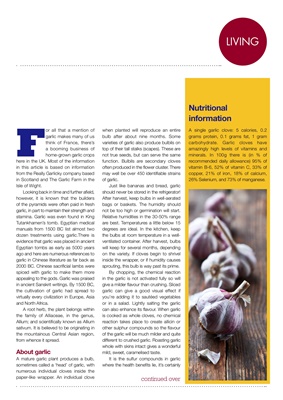
F
or all that a mention of
garlic makes many of us
think of France, there's
a booming business of
home-grown garlic crops
here in the UK. Most of the information
in this article is based on information
from the Really Garlicky company based
in Scotland and The Garlic Farm in the
Isle of Wight.
Looking back in time and further afield,
however, it is known that the builders
of the pyramids were often paid in fresh
garlic, in part to maintain their strength and
stamina. Garlic was even found in King
Tutankhamen's tomb. Egyptian medical
manuals from 1500 BC list almost two
dozen treatments using garlic.there is
evidence that garlic was placed in ancient
Egyptian tombs as early as 5000 years
ago and here are numerous references to
garlic in Chinese literature as far back as
2000 BC. Chinese sacrificial lambs were
spiced with garlic to make them more
appealing to the gods. Garlic was praised
in ancient Sanskrit writings. By 1500 BC,
the cultivation of garlic had spread to
virtually every civilization in Europe, Asia
and North Africa.
A root herb, the plant belongs within
the family of Alliaceae, in the genus,
Allium; and scientifically known as Allium
sativum. It is believed to be originating in
the mountainous Central Asian region,
from whence it spread.
About garlic
A mature garlic plant produces a bulb,
sometimes called a 'head' of garlic, with
numerous individual cloves inside the
paper-like wrapper. An individual clove
LIVING
continued over
when planted will reproduce an entire
bulb after about nine months. Some
varieties of garlic also produce bulbils on
top of their tall stalks (scapes). These are
not true seeds, but can serve the same
function. Bulbils are secondary cloves
often produced in the flower cluster. There
may well be over 450 identifiable strains
of garlic.
Just like bananas and bread, garlic
should never be stored in the refrigerator!
After harvest, keep bulbs in well-aerated
bags or baskets. The humidity should
not be too high or germination will start.
Relative humidities in the 30-50% range
are best. Temperatures a little below 15
degrees are ideal. In the kitchen, keep
the bulbs at room temperature in a wellventilated container.
After harvest, bulbs
will keep for several months, depending
on the variety. If cloves begin to shrivel
inside the wrapper, or if humidity causes
sprouting, this bulb is way past its prime.
By chopping, the chemical reaction
in the garlic is not activated fully so will
give a milder flavour than crushing. Sliced
garlic can give a good visual effect if
you're adding it to sautéed vegetables
or in a salad. Lightly salting the garlic
can also enhance its flavour. When garlic
is cooked as whole cloves, no chemical
reaction takes place to create allicin or
other sulphur compounds so the flavour
of the garlic will be much milder and quite
different to crushed garlic. Roasting garlic
whole with skins intact gives a wonderful
mild, sweet, caramelised taste.
It is the sulfur compounds in garlic
where the health benefits lie, it's certainly Nutritional
information
A single garlic clove: 5 calories, 0.2
grams protein, 0.1 grams fat, 1 gram
carbohydrate. Garlic cloves have
amazingly high levels of vitamins and
minerals. In 100g there is (in % of
recommended daily allowance) 95% of
vitamin B-6, 52% of vitamin C, 33% of
copper, 21% of iron, 18% of calcium,
26% Selenium, and 73% of manganese.